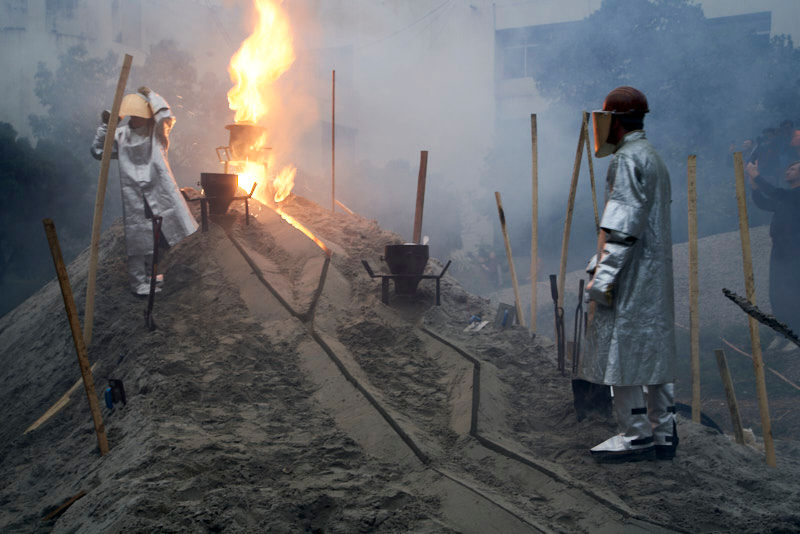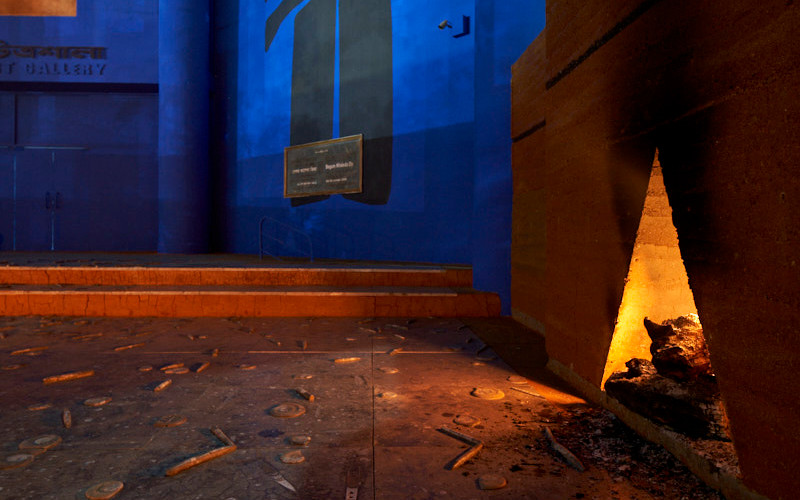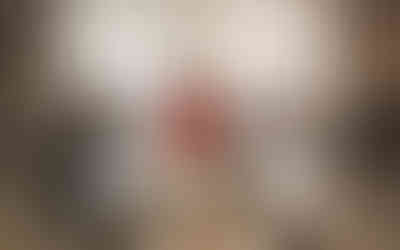We may think of ‘land’ as fixed but it is constantly shifting: below us through erosion, volcanic eruptions, and earthquakes; swirling above us as dust clouds. The earliest signs of life, the impetus of cellular movement, as well as aeons of extinction are inscribed in stone and fossils. Fossil fuels, created from the remains of life from the deep geological past, power much of our way of life and threaten our collective future through the violent process of extracting and burning them. Geological and political ruptures often overlap, and the artists in this movement excavate metaphors to consider our past, present, and future on this planet beyond human-bound paradigms. Their works challenge us to find commonalities and to emerge from this sediment to heal, imagine, design, and build new forms of togetherness. What will coalesce and fossilise our presence on this planet for lifetimes to come?
Adrián Villar Rojas
New Mutants, 2017–2020
Moroccan marble floor tiles encrusted with Devonian period micro Ammonite and Goniatites fossils; blue chroma key paint; spices (turmeric, chili powder, garam masala powder); plant-based pigments (indigo, sindoor, alta), gouache; sand; potatoes and coal, on aggregate rammed earth walls
Commissioned and produced by Samdani Art Foundation for DAS 2020
Courtesy of the artist, Samdani Art Foundation, Marian Goodman Gallery, and kurimanzutto
Realised with additional support from kurimanzutto and Marian Goodman Gallery
New Mutants is a new immersive installation by Adrián Villar Rojas where visitors enter DAS by walking over a marble floor encrusted with 400-million-year-old ammonite and orthoceras fossils. These now-extinct species of undersea creatures thrived for 300 million years, swimming across the super-ocean Panthalassa and witnessing the creation and breakup of the single continent Pangaea. A painting of a burned-out fireplace emerges from the rammed-earth walls that rise from the fossil floor, tracing the seismic shift that occurred in the evolution of humanity and our planet when we learned to control fire, invented agriculture, and began to settle and build civilisations. This work serves as a metaphor to think outside of human-bound time, and to consider common ground on which to come together.
Villar Rojas creates site-specific installations using both organic and inorganic materials that undergo change over time. Tied to their exhibiting context, they generate irreproducible experiences relying on a ‘parasite-host’ relation. His team-based projects that extend over open-ended periods allow him to question the aftermath of the normalised production of art in the Capitalocene era.
Fragments of this installation will be permanently on display at Srihatta, the Samdani Art Centre and Sculpture Park in Sylhet in a dedicated pavilion designed by the artist.
b. 1980, Argentina; lives and works nomadically
Elena Damiani
As the dust settles, 2019–2020
Watercolour on handmade Lokta Barbour grey paper. Commissioned for DAS 2020
Courtesy of the artist and Revolver Gallery
‘There is a strange sympathy between the atmospheric particles that float through the sky and the human beings who migrate across the ground and then across the sea. Each body sets the other into motion – a pattern of movement and countermovement.’ Adrian Lahoud
Elena Damiani has created a collage of watercolour renditions of storming dust particles in the atmosphere as captured by NASA. Several hundred million tonnes of dust unsettle and travel through the Atlantic and Pacific Oceans from deserts to the Caribbean, Central America, and South America. We imagine land to be static, but deforestation, desertification, and climate-change-related storms distribute dust across vast distances in our planet’s atmosphere. The handmade Nepalese paper beneath the layers of paint making up this work is a surface that could be read as stone tiles, an aerial view of a desert, or even a microscopic view of human skin.
Damiani creates installations, objects, and works on paper that focus on the politics of space and memory. She portrays landscapes and geological processes to reinterpret natural stages and their generative processes. Her work draws inspiration from collage techniques and historical science books, while the stone and metal in her sculptures recall the environments she studies and refracts.
b. 1979, Lima; lives and works in Lima
Jonathas de Andrade
b. 1982, Maceió; lives and works in Recife
Pacifico, 2010
Super8 transferred in HD, 12 min
Courtesy of the artist and Vermelho
Through the process of animating a styrofoam board model with maps and paper, Jonathas de Andrade proposes a fictional geological solution for the political turmoil and violence that normally accompanies changes of borders. A massive earthquake erupts over the Andes, detaching Chile from the South American continent. As a consequence, the sea returns to Bolivia, restoring its lost coastline, Argentina gains coasts with both the Pacific and the Atlantic oceans, and Chile becomes a floating island adrift in the seas. The aesthetic approach of the film allows the artist to touch upon topics such as the notion of truth as an ideological construction and the fabrication of mass commotion/emotion as political artifice.
De Andrade works predominantly with installations, videos, and photo-research. Addressing those overlooked in the dominant cultural narrative of Brazil, the artist ponders on the relationships between different social milieus. In collaboration with labourers, indigenous tribes, the disabled, and others, de Andrade commonly points out the inequality stemming from the discourses of colonialism and neo-imperialism. The artist co-founded the artistic collective A Casa como Convém in 2007.
Karan Shrestha
b. 1985, Kathmandu; lives and works between Kathmandu and Mumbai
in these folds, 2019
Ink on paper, three-channel HD video
Commissioned for DAS 2020
Courtesy of the artist
Within Nepal’s contained geography, the landscape presents possibilities for adversity to spring from any fissure: be it a decade of revolutionary upheaval, political instability, natural disasters, economic ruptures, repressed social edifices, or perpetual state violence. Through the installation of a three-channel video and an ink drawing, in these folds addresses the resulting precariousness that has characterised Nepal’s recent past. Incorporating documentary and fiction, Karan Shreshta questions the rhetoric of progress prescribed for paving the way forward and considers how transcendental practices that have endured over time are attempts at grappling with the everyday.
Shrestha’s works overlay encounters in physical landscapes on mental maps of people and spaces he comes across so as to examine and restructure notions of the present. His practice – incorporating drawings, sculpture, photography, text, film, and video – seeks to blur the oppositions that build and define our individual and collective identities.
Matías Duville
b. 1974, Buenos Aires; lives and works in Buenos Aires
Untitled, 2019
Sanguine on paper
My red way, 2019
Sanguine on paper
Levitating in red, 2019
Sanguine on paper, sandpaper
Courtesy of the artist and Barro Gallery
Matías Duville’s earthy mud and iron-oxide-infused sanguine drawings call to mind landscapes in transition from natural disasters and also from human interference from the extraction and clearing processes needed for infrastructure development. Similar to these methods, Duville’s drawings pulse with expressive brutality, trying to represent what the end of the world might look like both in a geographical and psychological sense. These works are inspired by the mental landscapes that are created inside our heads when we look directly at the sun and close our eyes to recover from its blinding light. The artist takes us along on his journey deep into the mind, trying to connect us with the idea of a universe out of control.
Duville works with objects, videos, and installations, although he predominantly employs drawing. His works evoke scenes of desolation with rarified, timeless atmospheres like those that precede a natural disaster: hurricanes, tsunamis, or situations of abandonment in the forest that act as a dreamlike vision of a wandering explorer, like a mental landscape.
Omer Wasim
b. 1988, Karachi; lives and works in Karachi
In the Heart of Mountains, 2019
Charcoal on canvas, lacquer, wooden armatures
Commissioned for DAS 2020
Courtesy of the artist
In the Heart of Mountains situates us amidst Omer Wasim’s journey in the mountains of the Gilgit-Baltistan region of Pakistan, a contested terrain that he scaled with queer friends and friendships. The work, as well as his action, denounces romantic visions and imaginaries of the area perpetuated by the state, and instead relies on charcoal to make visible the mountains as witnesses to state violence, colonial and neo-colonial rule, and as sites where many death-worlds arise. These mountains anticipate their own demise, foreshadowing capital interests in the region that are in diametric opposition to nature, ecology, and people. Queer bodies and community enable this mode of inquiry, becoming, in the process, insurgents that counter state-sponsored redaction and violence. While it also stands alone as an installation, the work also becomes an environment for new readings into the future.
Wasim is an intermedia artist whose practice queers space, subverting the frames of development and progress that shape human relationships to the city and nature. His work bears witness to the relentless erasure, violence, destruction of our times by staying with queer bodies as they hold space and enact desire.
Otobong Nkanga
b. 1974, Kano; lives and works in Antwerp
Landversation, 2020
Site-specific installation and conversations from Dhaka
Commissioned and produced by Samdani Art Foundation for DAS 2020. Courtesy of the artist, Samdani Art Foundation, and Mendes Wood DM.
Realised with additional support from Unilever Bangladesh. Project coordinator Helena Ramos
Land extends beyond mere soil, territories, and earth. It relates to our connectivity and conflicts in relation to the spaces we live in and how humans try to find solutions through simple gestures of innovation and repair. As relationships with nature and people become affected, how can we find a platform to share, learn, exchange and heal? A series of tables forming a circular structure serve as the basis for an exchange between visitors and a group of people who all have close – professional, caring, vital – relationships with the earth. Otobong Nkanga weaves together strands of landversations realised in Beirut, Shanghai, and São Paulo in this project’s newest iteration in Dhaka, and her collaborators have included geologists, housing and land rights activists, farmers, and many others who transform the land itself into other realities. What is ordinarily constructed through their contact with land now forms the foundation for new situations of exchange and transmission, activating interpersonal networks that come together in DAS with the power to move the world outside the exhibition.
Nkanga’s drawings, installations, photographs, sculptures and performances examine the social and topographical relationship to our everyday environment. By exploring the notion of land as a place of non-belonging, Nkanga provides an alternative meaning to the social ideas of identity. Paradoxically, she brings to light the memories and historical impacts provoked by humans and nature.
Raphael Hefti
b. 1978, Biel; lives and works in Zurich
Quick Fix Remix, 2015/2020
Sculptures created from performance
with thermite powder and sand
Courtesy of the artist. Realised
with additional support from Pro Helvetia
Raphael Hefti uses the language of material to communicate a fascination with the behaviour of liquid metals, a material history which is part of the epic story of human civilisation across vast geographies. This performance, a spectacle between blunder and precision, is a conversation with the world of heavy industries and iron casting. The artist misappropriates thermite welding processes typically used to repair high-speed train tracks, transforming liquid steel through a blazing landscape of incisions that leaves behind a bed of solidified metal debris. Just as volcanic eruptions make visible the hidden energy properties of the molten rock and liquid metal moving deep within the earth, Hefti’s ‘artistic alchemy’ makes visible the hidden industrial practices and processes that form the machine-made landscapes powering our way of life.
Working across sculpture, installation, painting, photography, and performance, Raphael Hefti explores how humans transform materials in the everyday urban landscape by pushing and testing material limits, while removing these materials from utilitarian obligations. He often works with teams of industry technicians to modify and misapply routine procedures and construction methods to open up new possibilities and unexpected beauty through guided accidents that he documents in his work.




















































